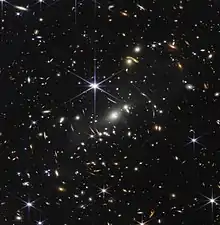.jpg.webp) Artistic depiction of Proxima Centauri d, with Proxima Centauri and Alpha Centauri A & B visible in the background | |
| Discovery[1] | |
|---|---|
| Discovery site | VLT-ESPRESSO |
| Discovery date | 2020 |
| Radial velocity | |
| Orbital characteristics[1] | |
| 0.02885+0.00019 −0.00022 AU | |
| Eccentricity | 0.04+0.15 −0.04 |
| 5.122+0.002 −0.0036 d | |
| Semi-amplitude | 0.39±0.07 m/s |
| Star | Proxima Centauri |
| Physical characteristics[1] | |
Mean radius | ≙0.81±0.08 R🜨 |
| Mass | ≥0.26±0.05 M🜨 |
| Temperature | 360 K (87 °C; 188 °F) |
Proxima Centauri d (also called Proxima d) is an exoplanet orbiting the red dwarf star Proxima Centauri, the closest star to the Sun and part of the Alpha Centauri triple star system. Together with two other planets in the Proxima Centauri system, it is the closest known exoplanet to the Solar System, located approximately 4.2 light-years (1.3 parsecs; 40 trillion kilometres; 25 trillion miles) away in the constellation of Centaurus. The first signs of the exoplanet emerged as a weak 5.15-day signal in radial velocity data taken from the Very Large Telescope during a 2020 study on Proxima b's mass. This signal was formally proposed to be a candidate exoplanet by Faria et al. in a follow-up paper published in February 2022.[2][1]
Proxima d is a sub-Earth at least one-quarter of the mass of Earth (or twice the mass of Mars), orbiting at roughly 0.029 AU (4.3 million km; 2.7 million mi) every 5.1 days.[2] It is the least massive and innermost known planet of the Proxima Centauri system. It is the least massive exoplanet detected with the radial velocity method as of 2022. Although Proxima d orbits too close to its star to have a habitable equilibrium temperature (which likely reaches 360 K (87 °C; 188 °F)[1] from about 190% of Earth's irradiation—assuming an Earth-like reflectivity, it is theoretically possible that Proxima d possesses polar regions with habitable temperatures.
See also
References
- 1 2 3 4 5 Faria, J. P.; Suárez Mascareño, A.; et al. (January 4, 2022). "A candidate short-period sub-Earth orbiting Proxima Centauri" (PDF). Astronomy & Astrophysics. European Southern Observatory. 658: 17. arXiv:2202.05188. Bibcode:2022A&A...658A.115F. doi:10.1051/0004-6361/202142337.
- 1 2 Suárez Mascareño, A.; Faria, J. P.; et al. (11 May 2020). "Revisiting Proxima with ESPRESSO". Astronomy & Astrophysics. 639: 24. arXiv:2005.12114. Bibcode:2020A&A...639A..77S. doi:10.1051/0004-6361/202037745. ISSN 0004-6361.


